
MONTREAL, Que. — We are stalled in the status quo, somehow.
The re-energized Conservatives have a new leader at the helm while the Liberals are being blamed for the cost of living and rising interest rates against a stream of headlines from the Emergencies Act inquiry.
Even so, two new polls find the Liberals and Conservatives deadlocked.
Let’s look at the numbers:
Ready steady: First, Research Co. measured a four-point lead for the Conservatives over the Liberals — 35 percent against 31 percent — from coast to coast, numbers well within 338Canada vote projection confidence intervals. The NDP (at 19 percent) and Bloc Québécois (8 percent) also stand at recent levels.
When asked who they’d prefer as prime minister, a plurality of respondents chose Justin Trudeau, although just a six-point gap (30 to 24 percent) separates him from Conservative Leader Pierre Poilievre.
The poll also found Canadians evenly split on the Liberal-NDP deal that keeps Trudeau’s minority government in power.
Likeability factors: A new poll from Abacus Data reveals similar results in the horse race. Abacus has the Conservatives ahead of the Liberals by three, 34 to 31 percent.
When the pollsters measured impressions of each leader, Trudeau earned significantly higher negative (49 percent) than positive marks (33 percent) for a net rating of minus-16. Poilievre also turned up in the red — at minus-6 — with 35 percent negative to 29 percent positive impressions.
Jagmeet Singh earned a plus-4, though his overall impressions have taken a dive.
Regional breakdowns: While the national numbers are mostly stable, the regional breakdown reveals modest movement for the Conservatives in Battlefield Ontario.
In 2021, the Liberals edged the CPC by a 4.4-point margin in the popular vote, which yielded a 41-seat advantage for the Liberals in Ontario. The newest polls suggest Conservative fortunes may be on the rise in the province, which would tighten the gap between parties.
According to Abacus, 37 percent of Ontario voters would have cast their ballots for the CPC had an election been held in late October — a three-point advantage over the Liberals. Considering the size of this regional subsample, this should be considered as a statistical tie.
Notably, Research Co. measured a more significant lead for Poilievre’s troops in Ontario: 41 percent for the Conservative against 32 percent for the Liberals.
The Research numbers suggest the most likely outcome would give the Conservatives the edge in seat count in Canada’s most populous province, in turn guaranteeing the CPC would win at least a plurality of seats nationally.
Abacus puts parties in a near tie, which would mean we’d likely end up with a broken Parliament.
Disclaimer time: Of course, we’re not expecting a federal election in the near future — not as long as the Liberal-NDP deal holds — so such exercises exist in the realm of political fiction.
The takeaways: Liberals could argue the party has not been irreparably eroded by wear and tear, and that Trudeau remains the leader that most Canadians would prefer to lead the country. They might also point out that although Poilievre will soon enter his third month as leader, the Conservatives have yet to experience a significant bump.
Of course, Conservatives could argue their base has never been stronger. It seems to have swallowed at least a part of the People’s Party of Canada support, which could help the Conservatives win many narrow races in southwestern Ontario and B.C.’s Lower Mainland.
The bottom line: Neither party can claim to hold momentum.
With Canada bracing for a recession, Deputy Prime Minister Chrystia Freeland has pledged to slow federal spending. The Liberals are probably thankful — with the benefit of hindsight — that they forced the 2021 election. Otherwise, the countdown to October 2023 would already be started — in less-than-ideal conditions for the party.

 2 years ago
2 years ago








 English (US) ·
English (US) ·